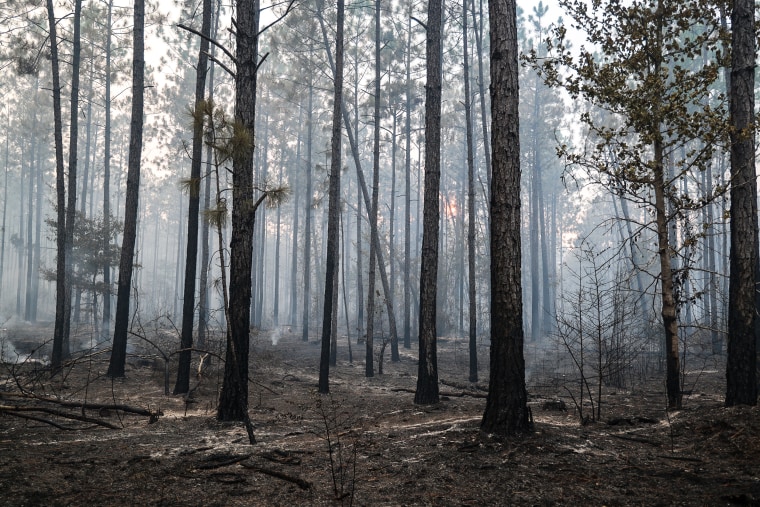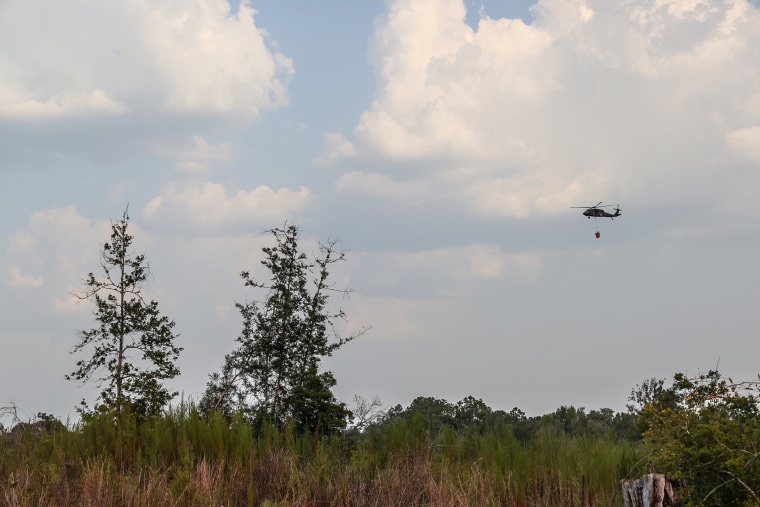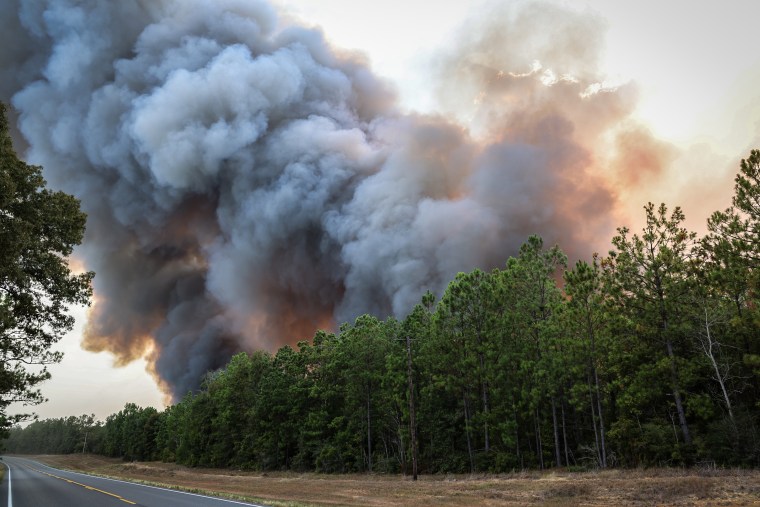Record-breaking heat, flash droughts and a high-pressure heat dome stretching across the South have helped create an “unprecedented” series of wildfires in Louisiana.
More than 31,000 acres have burned in the Tiger Island Fire, the largest wildfire in recorded state history, which remains only 50% contained.
All told, more than 511 wildfires have burned in Louisiana in August, Dr. Mike Strain, the state agriculture and forestry commissioner, said in an interview Tuesday.
“This is a firestorm,” said Strain, a veterinarian who has helped lead the state’s response. “When you think about looking out and seeing a wall of fire 8 miles long, that’s what you’re fighting.”
Typically one of the wettest states in the country, Louisiana has been uncharacteristically dry this year. Authorities don’t believe the largest of the fires will end until there is a heavy rainfall, which isn’t expected for some time.

The state has worked quickly in recent days to limit the Tiger Island Fire's growth in a rural part of southern Louisiana, despite a lack of experience and resources among the small rural communities to address this type of natural disaster.
Gov. John Bel Edwards said at a news conference Tuesday, however, that the next few days could lead to larger flare-ups after meager rain over the weekend didn't "materially change the conditions."
Multiple towns were forced to evacuate last week because of the fire conditions, but many people have been allowed to return in the past 24 hours thanks to the small amount of rain. Edwards warned that the public should remain vigilant, even if the smoke and the flames aren't as visible now.
"These are still going to be red flag conditions," he said. "And we have the strongest drought that we've ever recorded in Louisiana already, and then compounding this is all the fuel that is down in our forests left from Hurricanes Laura and Delta. ... You put all that together and you have a very volatile situation."
That fuel is the trees that were felled during the hurricanes, which struck Louisiana in 2020, as well as the detritus and the plant debris left over from the storms. The drought has dried out the vegetation and turned the brushes, grasses and small trees of southern Louisiana's swampland into the perfect kindling.
Allison Coons, a fire behavior analyst for the National Interagency Fire Center who is at the scene, said the fire burned in a "mosaic" pattern, meaning it has left areas unburned or slightly burned within the greater affected area. That has meant that the fire continues to have fuel sources, even if it were fully contained, and that it could flare up relatively easily.
With water levels falling in the swampy area, exposing roots and other brush, embers can skulk underfoot until the right conditions allow the fire to grow again.
"You've got a lot of burnable material that is now available for that fire," said Coons, who emphasized a long rain would be necessary to extinguish the fire. "It can creep through that area, and then once it gets hit by a good amount of sun or the wind hits it just right, then it can get up and start making some movement."

Because the region so rarely burns, first responders, largely volunteer fire fighters in this rural part of Louisiana, struggled with a lack of resources in the early days of the blaze.
The area fire departments were aided by residents in the region before federal aid arrived, said Bonnie Strawser, the federal public information officer for the Tiger Island Fire. Lumber workers and farmers joined the effort with their bulldozers and whatever other machinery they could use to build containment lines.
"I wanted to go hug each one of those guys, because they looked worn down and beaten to death because they had been working 20-hour days and going home and sleeping four hours," she said. "They'd been doing that for four days and just going as hard as they could trying to get dozer lines around the fire."
Now, with the help of other states, more than 1,000 firefighters have come to the area to help. Strain said Louisiana has also coordinated with the Federal Emergency Management Agency, the U.S. Agriculture Department, the U.S. Forest Service and other federal agencies.
Louisiana has needed the help because of its lack of experience with drought.

Barry Keim, a climatologist at Louisiana State University, called it "the summer from hell." He said a high-pressure system has lingered over the South for months, leading to the hot, dry conditions. The issue is worsened by the El Niño season, climate change and "just natural climate variability," he said.
"It's just like all these things came together, creating the worst summer conceivably possible in south Louisiana," Keim said.
The silver lining for Louisiana on the 18th anniversary of Hurricane Katrina and as a major storm threatens Florida, he said, is that the pressure system that contributed to the wildfires appears to have kept hurricanes away.
"It's apocalyptic in many other ways," he said, "but at least we don't have that."
